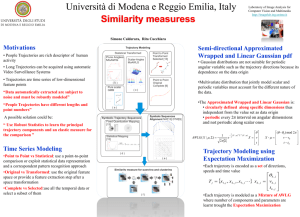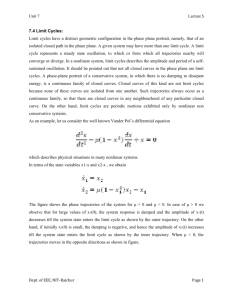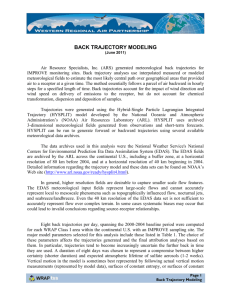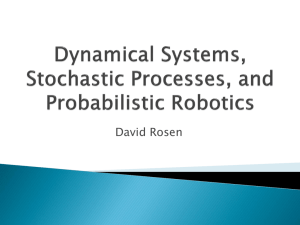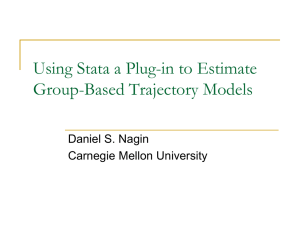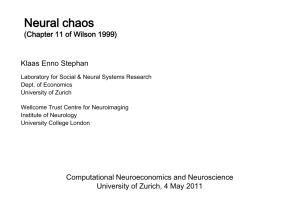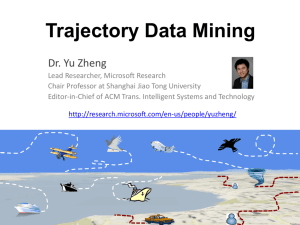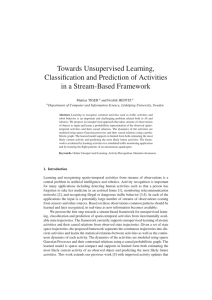Research Interests
advertisement
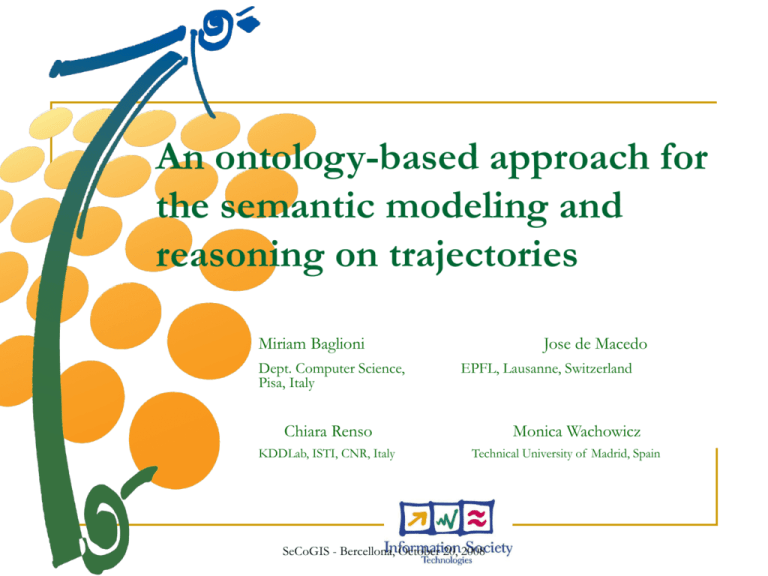
An ontology-based approach for the semantic modeling and reasoning on trajectories Miriam Baglioni Dept. Computer Science, Pisa, Italy Jose de Macedo EPFL, Lausanne, Switzerland Chiara Renso KDDLab, ISTI, CNR, Italy Monica Wachowicz Technical University of Madrid, Spain SeCoGIS - Bercellona, October 20, 2008 Introduction Mobile communications and ubiquitous computing pervade our society Wireless networks sense the movement of people and vehicles, generating large volumes of mobility data. A scenario of great opportunities and risks: analyzing mobility data can produce useful knowledge; individual privacy is at risk, as the mobility data contain sensitive personal information. A new multidisciplinary research area is emerging at this crossroads, with potential for broad social and economic impact. SeCoGIS - Bercellona, October 20, 2008 2 The scenario 3 Trajectories Managing location information gives the possibility to access space-time trajectories of personal devices. Trajectories are the traces left behind by moving objects and individuals Trajectories offer opportunity to extract behavioral patterns SeCoGIS - Bercellona, October 20, 2008 4 Raw Trajectories A trajectory is the user defined record of the evolution of the position of an object that is moving in space during a given time interval in order to achieve a given goal. trajectory: [time interval] → space. Mobile devices produce raw location data (obj-id, x, y, t) SeCoGIS - Bercellona, October 20, 2008 5 The scenario: the need for semantics Which are the malicious/tourist/ … activities? 6 From Raw Trajectories to Semantic trajectories Semantic Trajectory defined as sequence of Stops and Moves. Stop is where the position of the object stays fixed Move is the part of the trajectory where the position changes. Monument [10:30 – 12:30] Hotel [09:00 – 10:00] Restaurant [13:00 – 15:00] 7 The need for semantics and reasoning Movement data is complex Movement happens always in a geographical space, that affects and gives meaning to the movement itself. Adding semantics may support the user in the interpretation and understanding of trajectories as people behavior or activity: suspicious behavior or tourist activity can be inferred from a motion pattern. 8 The trajectory enrichment process 9 The role of the ontology Ontology (Description Logics) as a knowledge representation and reasoning formalisms : Trajectories + Geography + Domain expert knowledge. Geographic and domain knowledge may fit well a concept hierarchy and this give an additional power to the system since it can encode and infer new knowledge. Reasoning tasks: Consistency of ontology: Classification by instance checking of individuals (instances) into concept categories. 10 Semantic representation of movement data Semantic Trajectory CityPlace stop_is_at trajCompOfStop Monument Church … Bridge Stop Museum is_a relationship object property Malicious Activity Time Move stophasDuration 11 Motivating Example General lack of knowledge of recreation planners about the actual movement of players within a recreation site. The assumption is that game activities are not always performed in planned recreational zones. Thus an analysis of movements would allow a better understanding of how people behave during the game. 12 Motivating Example Paper chase is an old children’s game in which an area is explored by means of a set of questions and hints on a sheet of paper. Each team tries to find the locations that are indicated on the questionnaire. Once a place is found, they try to best and quickly answer the questions on the sheet, note down the answer, and proceed to the next point of interest (POI). Game Frequency 1550 by Waag Society. Students are transported to the medieval Amsterdam of 1550 with the mobile phone. 13 Understanding movements A malicious activity of the tracked kid is represented by a trajectory that has some short stops at a bridge (kids launching stones in the water). The reasoning engine checks if an individual (a given trajectory) is an instance of a concept (malicious activity). The class Malicious Activity is an implicit class defined in the ontology by an axiom: a combination of logical operators NOT_GAME_STOP (StopHasTime some (hasDuration some LONG)) or (StopHasTime some (hasDuration some SHORT)) GAME_STOP StopHasTime some (hasDuration some MEDIUM) MaliciousActivity trajIsCompOfStop some (NOT_GAME_STOP and (StopHasTime some (hasDuration some SHORT)) and (is_at some BridgePlace)) 14 Ongoing work We are currently extending this work in two main directions: Integrating data mining in the scenario: understand people behaviour analyzing large amount of data. From millions of trajectories, data mining extracts movement patterns. Developing a prototype based on Oracle11g Semantic Technologies, OWLPRIME language: ATHENA. We are currently experimenting the system in a larger dataset coming from GPS on cars and moving in Milan. 15 Athena: Trajectories and city places 16 Athena: Tourist trajectories 17 Athena: The Ontology 18 Conclusions Movement data is complex and strictly related with the geographical space where people move. Raw trajectory data is not enough to understand people behaviour: the need for semantics and reasoning An approach to semantic enrichment process, based on ontology formalism, to infer behavior classes. www.geopkdd.eu 19

